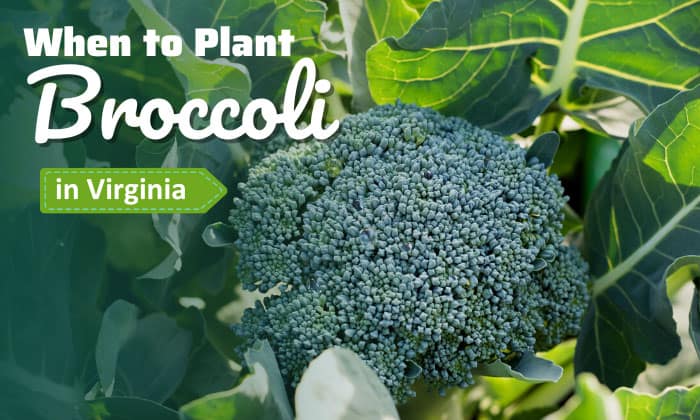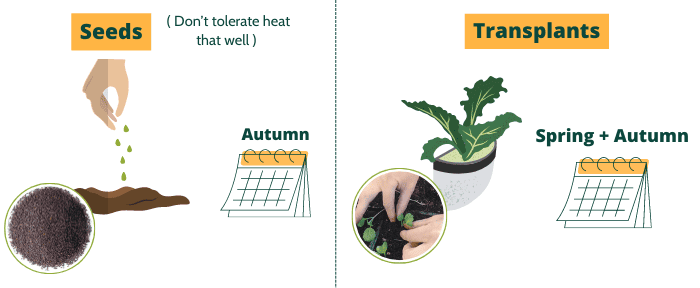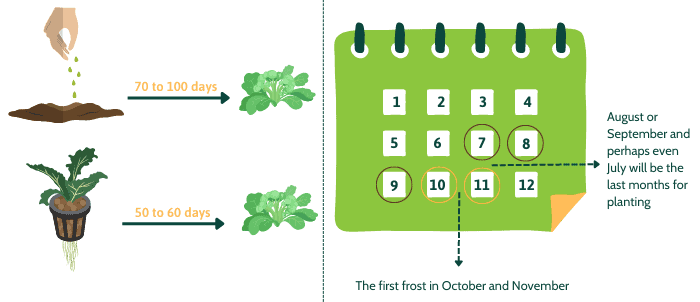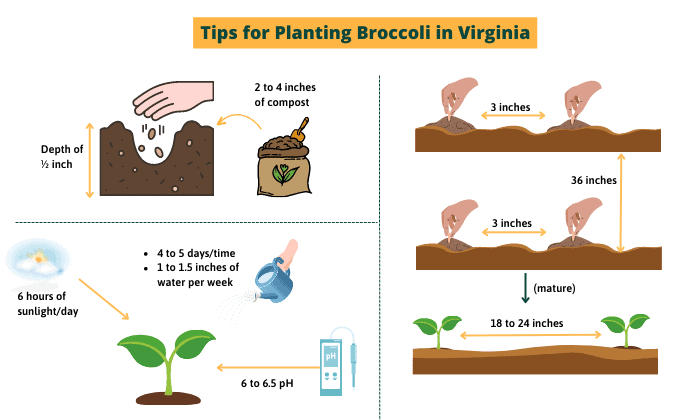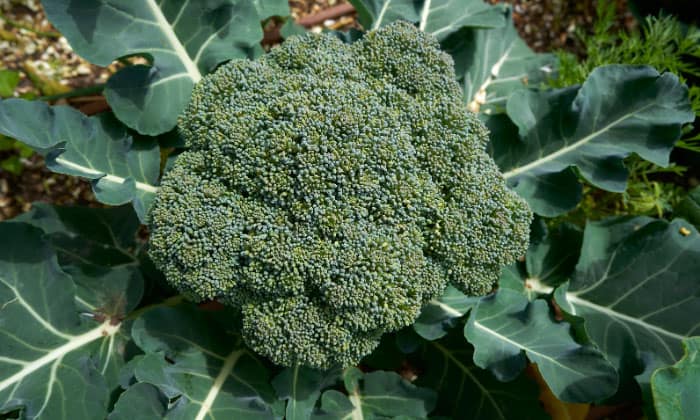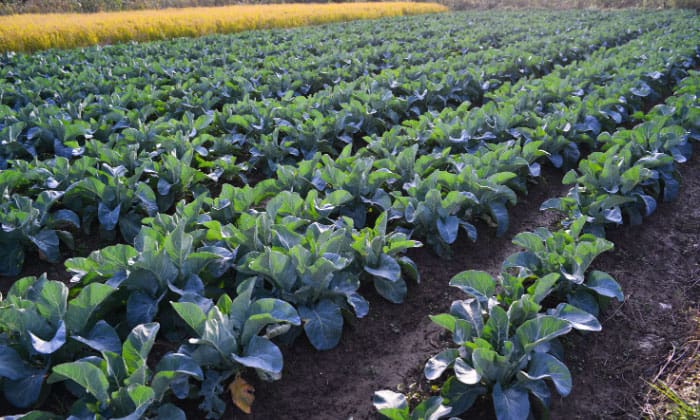High in fiber and vitamin C, broccoli is a favorite vegetable for many Americans. If you’re planning to grow this cool-season crop in Virginia, note that it’s best to plant broccoli seeds around mid-February and March indoors or from June 20 to July 20 outdoors.
Meanwhile, transplants may be grown outside around April 1 to April 20 or from July 15 to August 20 for fall harvest, though these estimates can change depending on your location.
Read on for details on when to plant broccoli in Virginia.
Table of Contents
Best Time to Plant Broccoli in Virginia
1. Plant indoors and outdoors in spring and fall.
When growing broccoli in Virginia, you can pick either seeds or transplants. However, seeds are best reserved for fall because they don’t tolerate heat that well, while transplants are suitable for both spring and fall planting.
Here are the guidelines for these two methods. Note that you can still use seeds in the spring if you want. All you have to do is:
- Sow seeds indoors in pots eight weeks before the last frost or outside three weeks before it. Fall planting of seeds may begin ten to twelve weeks prior to the first frost.
- Alternatively, you may transplant broccoli outside after the final frost in spring or around six to eight weeks before the first frost. Either method will do.
Given that Virginia’s weather starts to warm up around April 5 to May 15 and turns freezing cold in October and November, the state’s planting season should be from February to March and last up until August or September.
Below are the frost estimates for some regions in Virginia you can refer to.
| Location | Final frost | First frost |
| Aquia Harbour | April 2 | November 3 |
| Charlottesville | April 10 | October 31 |
| Danville | April 15 | October 27 |
| Highland Springs | April 9 | October 31 |
| Linton Hall | April 17 | October 22 |
2. Planting time for different areas
Here is the growing season for broccoli transplants in different hardiness zones of Virginia.
- Zone 5a and 5b – March 15 to April 1 or July 1 to 15
- Zone 6a – April 5 to May 25 or July 15 to August 25
- Zone 6b – March 25 to May 15 or July 15 to August 25
- Zone 7a – March 15 to May 5 or July 25 to September 5
- Zone 7b – March 5 to April 25 or August 5 to September 15
- Zone 8a – February 25 to April 15 or August 15 to September 25
3. How late is too late to plant broccoli in Virginia?
Broccoli has a maturity time of 70 to 100 days from seeds and 50 to 60 days from transplants, so it should have about two to three months to grow before frosty weather arrives.
If we take into account the first frost in October and November in Virginia, August or September and perhaps even July will be the last months for planting.
Varieties of Broccoli to Plant in Virginia
| Variety | Attributes |
| Castle Dome | Matures in 50 days from transplants. Heat and bolt-resistant with heavy, uniform heads growing from stem. |
| Belstar | Matures in 66 days from transplants. Resistant to downy mildew and cold weather. |
| Gypsy | Matures in 60 days from transplants. Resistant to downy mildew as well as cold and hot temperatures. |
| Emerald Crown | Matures in 63 days from transplants. Resistant to extreme temperatures and suitable for fall planting. |
| Imperial | Matures in 72 days from transplants. Heat-resistant with big heads that suit freezing and processing. |
| Arcadia | Matures in 63 days from transplants. Resistant to black rot and downy mildew, with firm dome heads and productive offshoots. |
Tips for Planting, Caring for, and Harvesting Broccoli in Virginia
Sow broccoli seeds at a depth of ½ inch in fertile soil with two to four inches of compost. You may position the plants three inches apart, but it will be necessary to thin them down later for a spacing of 18 to 24 inches. As for rows, 36 inches of distance between them should suffice.
Ideal growing conditions for broccoli include six hours of sunlight per day, a watering every four to five days for a total of one to 1.5 inches of water per week, and a 6 to 6.5 pH for broccoli.
To care for the plants, apply a 5-10-10 fertilizer before sowing and a nitrogen dressing three weeks after.
2.5 pounds of plant food every 50 square feet at planting time will suffice, while the subsequent nitrogen should come from a 21-0-0 formula at a rate of ¼ cup every five feet.
If you’re unsure when to harvest broccoli, here are some tips:
- See if the broccoli crowns are compact and dense—this state indicates they’re ready for eating. If the heads have started to ‘loosen’ up, pick them immediately, or the flavors won’t be as great.
- Moreover, check whether flowers have appeared on the florets. If you see yellow flowers on your plant, you’ve missed the best window for collecting broccoli and should not wait any longer to pick it.
- To harvest your crop, simply cut six inches below the head then refrigerate Continue caring for the in-ground broccoli afterward so that it produces new heads on its side shoots, which you can collect later.
Factors That Affect the Optimal Time to Plant Broccoli in Virginia
Broccoli grows best at 40 to 75℉. Below 40 degrees, the plant may form heads and flowers prematurely, which means its development will come to an abrupt end, leaving you with no sizable broccoli heads to enjoy.
This is the reason why it is necessary to plant broccoli outside when the soil is warm, and frost is pretty much gone.
It’s also important to note that broccoli is not very cold-hardy and will die if temperatures dip below 26 degrees Fahrenheit. Moreover, it is susceptible to bolting if transplanted too late under cold weather.
Hence, those who plant fall broccoli should move it outside when the seedling has four or five leaves when it is established enough to withstand cool weather outdoors and avoid transplant shock.
Extreme cold aside, do not expose broccoli to hot weather at 95 degrees Fahrenheit (or 35 degrees in growing temperature Celsius), as this condition can create uneven heads.
Frequently Asked Questions
What are the best companion plants for broccoli in Virginia?
You can plant sage, peppermint, and dill as companion plants for broccoli if you enjoy herbs. Vegetables like beet, corn, onion, and spinach are recommended, as are plants like sunflowers and nasturtiums.
What are some common pests and diseases that affect broccoli in Virginia?
Here are some problems you should watch out for when growing broccoli in Virginia.
| Problem | Symptoms | Management/Control |
| Cabbage loopers | Small holes with brownish-green excrement | Handpicking or insecticidal soap and sprays such as Bt, pyrethrins, and spinosad |
| Cabbage worms | Large holes with yellow eggs on leaves | Same as cabbage loopers |
| Diamondback moth worms | Holes on the undersides of leaves | Floating row covers and Bt insecticide |
| Aphids | Curled yellow leaves with a sticky substance. Sooty mold on the plant that looks ‘ashy’ | High-pressure water sprays or neem pesticide and pyrethrins |
| Downy mildew | Fungal growth that creates yellow blotches on the upper side of leaves and white/gray/purple spots underneath them. Can cause wilting and foliage death. | Plant resistant varieties and water at the roots only. |
| Black rot | V-shaped lesions on leaves with blackening around the edges | Disease-free seeds and copper sprays, plus a three-year rotation system |
| White mold | White/grayish lesions on leaves and stems | Remove weeds and apply a copper fungicide |
Conclusion
Knowing when to plant broccoli in Virginia is essential for those who want to cultivate this crop in their garden. Broccoli yield per plant can weigh three to six pounds on average, making it an excellent choice if you want fresh, nutritious vegetables for the whole family.

Hi, I am William – Floridayards’ digital content creator. My job is to find answers to all your concerns with thorough research and our team’s expert advice. I will also bring you honest reviews on the best products and equipment for raising your beautiful garden. Please look forward to our work!


